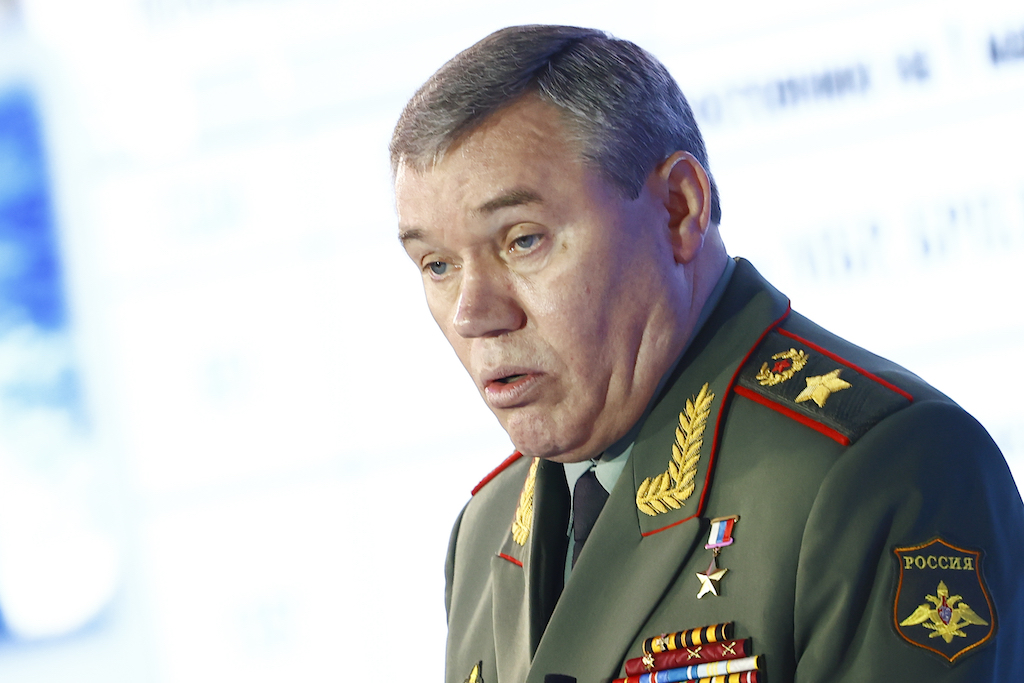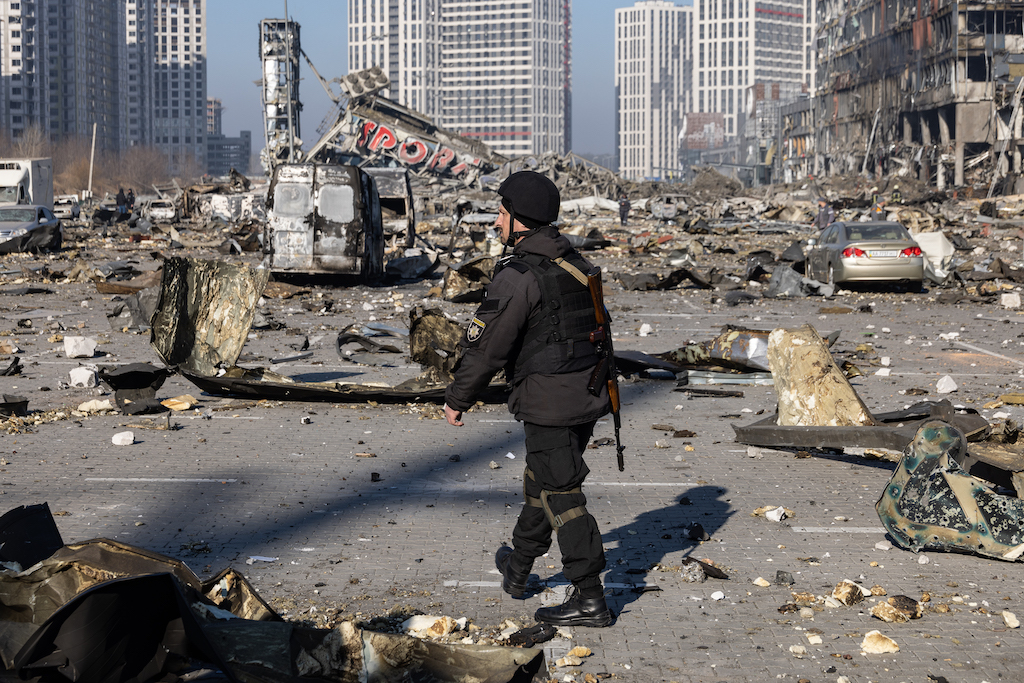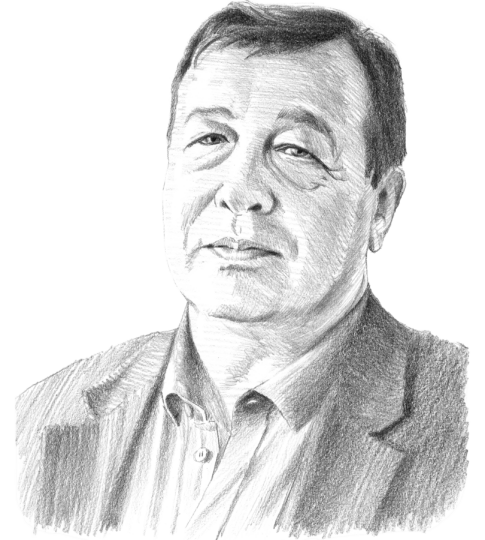Russia-Ukraine war: Scenarios
Russia is ramping up its brutality in Ukraine and threatening the outside world to maintain the appearance that it still controls the war. NATO could counter this strategy.

In a nutshell
- With its troops stalled in Ukraine, Russia keeps escalating the war
- Upping the ante when things go badly has been part of its military strategy
- NATO could respond by making escalation steps riskier for President Putin
One of the characteristic features of the current Russian war against Ukraine is Moscow’s practical application of its strategic invention: the doctrine of warfare escalation. The principle of this strategy can be put as follows: when you are in danger of losing a war, escalate it. Always run toward trouble, never back away. If you are not doing well in local fighting, try to settle it in your favor by making it a regional war. When that does not do the trick, up the ante by threatening to expand the conflict into a global war. And if you are losing a conventional struggle, escalate it toward a nuclear war.
A particular case of this doctrine is the concept of the so-called “nuclear de-escalation,” ending a conventional conflict by intimidating opponents with limited use of nuclear weapons. This concept assumes that if Russia finds itself on the verge of losing a conventional war and its vital national interests are at stake, it could execute a warning shot using a tactical nuclear warhead. Not necessarily targeting an enemy object, but, for example, exploding it in the air or off the coast.
The message to the other side would be: stop, end this war, sit down at the table, negotiate a truce because we are already on the verge of a nuclear war. We do not believe you want this.
This is the Russian nuclear umbrella concept for limited wars, including possible wars against NATO countries.
Escalation in military practice in Ukraine
The essence of the escalation doctrine is seeking military victory by blackmailing opponents with the conflict’s rising costs – to the point of breaking the endurance of the other party. Russia is practicing this doctrine in the current war with Ukraine.
It started the war as a punitive expedition against a weak country. (The strategic mistakes made by the Russians in the preparations and the first stage of the invasion deserve a separate analysis.) Then it quickly became evident that the war could not be won this way. One cannot simply roll military columns across today’s Ukraine, on roads and highways, through towns and villages, and with forces dispersed along its borders. So, in phase two, the Kremlin opted for escalation, from an expeditionary war to total war.
Russia could decide to move to higher rungs of the escalation ladder.
Russian troops engaged in regular fighting with the Ukrainian army and in a campaign of bombing and shelling of cities, infrastructure and civilians. It hoped that such ruthless violence would break the will of the Ukrainian people to resist and force a capitulation, or at least very significant concessions, by the Ukrainian authorities.
However, things have not developed as planned. Especially in the north, Ukraine defended itself persistently and deftly, notably defeating Russia in the Kyiv operation. The setback forced Moscow to reorient its political and strategic goals. It abandoned its original intention of conquering all of Ukraine; the new plan calls for the annexation of eastern and southern parts of its territory along the Black Sea shores.

The escalation of the conflict includes war crimes committed by the Russian side: individual and mass murders in the occupied territories and deportations of population groups out of Ukraine, including to Siberia – that is, ethnic cleansing practices known from the darkest chapters of Russian history, the tsarist and Bolshevik repressions.
Russia’s second plan for the invasion is simple. Terrorist pressure in the occupied territories coupled with the encircling and destruction of the Ukrainian army’s main forces in Donbas are supposed to break the Ukrainians’ resistance and enable the creation of new separatist republics in southern Ukraine.
However, the Ukrainian army, supplied by the West with increasingly modern, effective weapons, has a chance of success in this phase of the conflict as well. The Ukrainian nation shows no intent to capitulate. As a result, the war could end in a military stalemate and a frozen conflict – or Russia could decide to move to still higher rungs in the escalation ladder.
How they may do it
This could escalate into a war with weapons of mass destruction. Apparently, Russia has been preparing for a provocation involving chemical, biological or radiological agents. The plan probably called for blaming the West for deploying such a weapon while causing shock and terror among Ukrainians and Western opponents. A seemingly coordinated appearance of fake news in the media (about secret laboratories in which Ukraine and Western countries worked jointly on biological weapons) indicated preparations for such a provocation.
It also has been no coincidence that Russian troops recklessly prowled the site of the former Chornobyl nuclear power plant and the nuclear power plant in southeastern Enerhodar, the biggest in Europe, captured by the Russian army at the beginning of March.
Low-power tactical nuclear charges could carry out devastating blows on selected strategic objects of Ukraine.
A possible escalation with the use of nuclear weapons is a separate issue. Until recently, such a scenario in Ukraine seemed remote. After the defeat in Kyiv, as Russia is at risk of losing the war, assessments have changed. First, there could be a demonstration, a nuclear blast high in the air, preceded by a warning. If Kyiv did not capitulated despite such a threat, low-power tactical nuclear charges could destroy selected strategic objects of Ukraine.
Attempts to de-escalate
Now, let us look at how Ukraine and the West – the third party in the Russo-Ukrainian confrontation – and their attempts to deal with the Russians’ method of escalating warfare.
As a nonnuclear state invaded by a nuclear power, Ukraine has no other means of counteracting the escalation of the conflict than calibrated military resistance and persistent strategic resistance of the nation and the state.
The Ukrainian people are not succumbing to increasing pressure from Russia, despite suffering horrible losses. From a political standpoint, the state has not capitulated and continues to function. The Ukrainian army has, so far, successfully repelled military aggression, and seems to retain strong morale despite inevitable casualties.
The West, in turn, is responding with proactive methods to Russian escalation steps. It has imposed unprecedented political and economic sanctions on Russia and steadily expanded its aid to Ukraine.
Of late, it started supplying the Ukrainian army with heavy offensive weaponry. However, we mainly see a defensive strategy with retaliatory steps that follow Russian actions. The defense against the Russian escalation presently consists of resistance and tactical counterattacks by Ukraine, and operational counterattacks by the West.
How Russia can shed centuries of corruption
Limits of defensive de-escalation
Resistance alone can occasionally stop an opponent, and active defense can force the enemy to back down for a time. However, the opponent’s defeat can only result from a successful strategic counterattack, a counteroffensive. Similarly, in the struggle with the Russian war escalation in Ukraine, defense alone is not enough to win the war.
The West is not actively disrupting Russia’s escalation practices. Aid for Ukraine comes mainly in response to Russia’s belligerent actions.
Defensive actions are unlikely to force Russia to de-escalate the war and end it. For this, one needs an offensive de-escalation strategy. Instead of imposing sanctions on Russia ex-post – punishing it for hostile actions after the fact – the West needs to put pressure on Moscow to do something desired by Ukraine and its allies. In other words, force a de-escalation.
Such pressure comes down to a preemptive ultimatum. For example: if in two days you do not stop introducing new troops to the territory of Ukraine, you will face such and such consequences; if you do not start withdrawing troops from Ukraine within a week, we will introduce more sanctions, and so on.
The same applies to supporting Ukraine. The West is not actively disrupting Russia’s escalation practices, and aid for Ukraine comes mainly in response to Russia’s belligerent actions. Early in the war, caving in to a Russian escalation threat, the West even restricted its military support to the Ukrainian army to supplying only light defensive weapons, and stopped military training aid.
The biggest mistake was the “red line” drawn by United States President Joe Biden, who early on ruled out direct involvement of American soldiers in Ukraine. That announcement eliminated the possibility of NATO’s direct participation in the fighting and granted Russian President Vladimir Putin what one may call “escalating comfort.” The U.S. leader ignored the basic rule of the deterrence strategy: never tell your opponent what you will not do when confronted with him.
Making it harder for Mr. Putin
Instead of drawing such counterproductive “red lines,” the West should seek to limit Russia’s freedom in escalating the conflict. This could be achieved by making it difficult for Mr. Putin to find ways to do so at minimal risk. It is difficult to end a war when only one side dares to raise the stakes in the game. The Russian leader and his strategists should face the dilemmas of choice and the necessity to take risks that are difficult to estimate.
In addition to supplying Ukraine with weapons in its proxy war with Russia, the West could also protect transport and bases with humanitarian and military aid against air and land attacks. As part of this task, the West could create some additional, hard-to-climb levels for President Putin on his ladder of escalating aggression against Ukraine.
Firstly, the West could announce that, at the request of Ukraine and given the increase in readiness of Russia’s nuclear weapons, all dual-purpose Russian missiles – that is, capable of carrying conventional and nuclear charges – going over Western Ukraine in the general direction of NATO countries will be shot down.
An escalation could involve the tools of mass destruction, including nuclear weapons.
Secondly, NATO could declare that if Russia fails to stop such missile attacks, a full-fledged antimissile defense zone will be established over Western Ukraine. Third, if this is still not respected, the missile restriction will be extended to a no-fly zone west of the Dnieper River. In addition, if attacks on convoys and bases with Western supplies for Ukraine continued, direct land protection will be introduced, including anti-diversion and antiaircraft measures.
Such defensive actions would face Mr. Putin with hard decision-making dilemmas: should he risk an escalation in the air war and in subversive operations on the Ukrainian territory? An escalation of this sort could confront Russia with NATO forces – right at a time when it has had huge problems dealing with the Ukrainian army alone. So maybe it would not be such a bad idea to start looking for ways of real de-escalation and a path to a truce?
Russia’s attempt to build a Third Empire
Scenarios
Russian victory
The scenarios for the outcome of the Russian-Ukrainian war and the proxy war between Russia and the West largely hinge on the West’s attitude. Ukraine has little choice but to continue its resistance. Russia also has limited maneuver room: domestically, it cannot afford to lose the war, and it cannot win militarily either, due to Ukraine’s effective resistance. What is left for Moscow is to seek a victory by further escalating the conflict or de-escalate to exit the war.
This, however, brings us back to the Russian military doctrine that says that the best method of de-escalation is through an escalation. As a result, the most likely scenario for this war is its further escalation by Russia.
Such an escalation could involve mass destruction tools, including nuclear weapons. So, we arrive at a terrifying but inevitable vision of crossing the threshold of a nuclear war in Europe. A bold Russian escalation could end the war in Ukraine and bring Russia a final victory.
In this scenario, Russia, having ruined and commandeered Ukraine, could follow up in the second Cold War with the West – with a nuclear axe in hand. Repeating the Ukrainian variant of limited aggression against one of the NATO countries could become its primary tool for blackmailing the West. Therefore, NATO urgently needs to find an adequate response to Russia’s doctrine of warfare escalation.
Western success
The second scenario is, of course, a de-escalation, i.e., a cease-fire and a temporary military truce that could lay the groundwork for a political end to the war – without defeat and surrender by either side. Vladimir Putin’s Russia will not be willing to do so, however, as long as it has at its disposal low-risk steps on the escalation ladder.
In the final analysis, the de-escalation scenario depends on the active posture of the West, namely the U.S., NATO and the EU. Several tools could enable the implementation of such a policy. They include an offensive strategy of the sanctions policy; unlimited non-kinetic (information, logistic, training, advisory) support for the Ukrainian army; military protection of its own humanitarian, economic and military aid on the territory of Ukraine outside the zone of direct armed clashes (in western and central Ukraine); and unambiguous and decisive deterrence – confirmed by an appropriate development of the combat readiness of troops on the eastern flank, with a simultaneous declaration on the principles of NATO’s nuclear policy – which would prevent Russia from escalating operations on the territory of the alliance.
An active de-escalation scenario forced on Russia could bring the war in Ukraine to an end and assure a relatively stable, predictable course of the subsequent confrontation between Russia and the West under the conditions of the Second Cold War.











